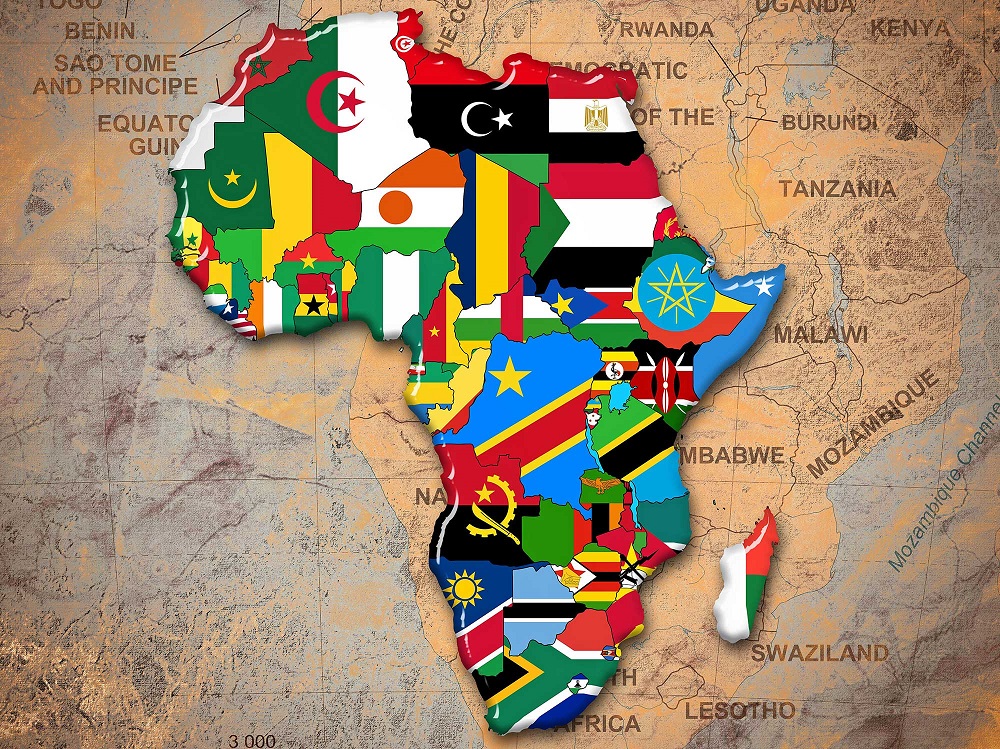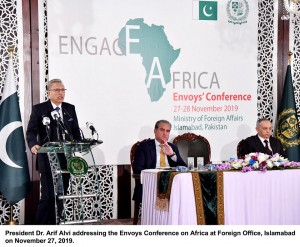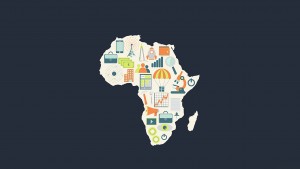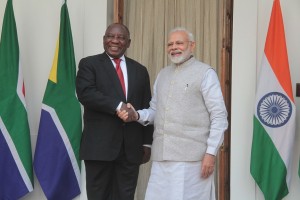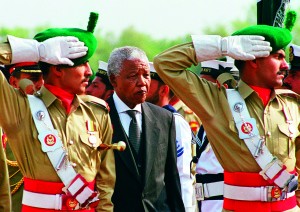THE SUN IS RISING ON THE DARK CONTINENT!
Global Economic and Geopolitical Tilt toward Africa
Hassaan Bin Zubair
In its long history, Africa has served the global ambitions of many foreigners. Foreigners have reached out to Africa as missionaries, financiers, and infrastructure builders. Even today, investors and trade partners have their sights set on Africa. The two major players of global politics, i.e. the USA and China, and to a certain extent Europe, are competing to strengthen their economic linkages within Africa. India and Pakistan have also entered the fray. The principal reason behind this power play is that the countries on this continent are blessed with huge natural resources like rare earth metals, oil and gas and other precious minerals. Moreover, all these countries want to boost their potential share in the African market, which is very dynamic, with a young population and reasonable growth rates.
Africa is a continent of growth and opportunities today. With a young, fast-growing youth population and considerable natural resources and human capital at its disposal, Africa is poised to be a significant growth factor in the global economy. Positive winds of change are sweeping across the continent, which is now home to half of the world’s top ten fastest-growing economies. Africa is an opportunity, one that is being shaped by and for the African people. In the instant write-up, we will discuss the Africa policies of the United States, China, India and Pakistan and will find out why the Dark Continent is important for all these countries.
In June 2019, the 12th US-Africa Business Summit, a high-level event attended by 11 African heads of state and government and some 1,000 business leaders, was held in Maputo, Mozambique. During the three-day event, US officials unveiled a $60bn investment agency which will seek to invest in low and middle-income countries, with a special focus on Africa. The summit was held under Trump administration’s ‘New Africa Strategy’ titled the Prosper Africa initiative which asserts that “[America’s] Great power competitors, namely China and Russia, are rapidly expanding their financial and political influence across Africa. They are deliberately and aggressively targeting their investments in the region to gain a competitive advantage over the United States.”
Traditionally, the United States has viewed Africa as a battlefield where it can confront its enemies, whether the Soviets during the Cold War, terrorists after 9/11 or now the Chinese. Washington has never really made a concerted effort to develop its economic relations with the continent. As a result, trade between the US and Africa has decreased from $120bn in 2012 to just over $50bn by June 2019. The pressure the US is currently exerting on African countries to move away from partnerships with China could hurt African economies. It could force African countries into making choices that are not in their best economic interests and miss out on important development projects or funding.
According to John Bolton, President Trump’s National Security Advisor at the time when US new strategy towards Africa was announced, the new strategy will be guided by the principle of ‘American interests first’ and focus on three areas. Economic cooperation will be strengthened with the ‘Prosper Africa’ plan by signing more extensive bilateral economic agreements and supporting American investments in Africa. In terms of anti-terror and military cooperation, the US will continue striking ISIS and other extremist organizations in Africa while gradually reducing American military presence there by about 10 percent in the coming three years. In terms of assistance, the US will target its funding selectively toward key countries and particular strategic objectives instead of indiscriminate assistance across the entire continent so as to achieve higher efficiency for American assistance. In other words, there will be no equal treatment without discrimination in the future. Instead, while providing assistance to Africa, the US will select the recipients and determine the amounts completely on the basis of their closeness to the US. Bolton announced that the US is making a global assistance strategy to make sure any sum of aid money is being used to advance American interests. He was also explicit that those countries voting against the US on international forums or taking actions counter to US interests ‘should not receive generous American aid.’
Thus, the Trump administration’s message to Africa has been blunt: Choose the United States over China and Russia.
- China
China’s approach to Africa has always been trade oriented. The continent became one of the top destinations for Chinese investment after Beijing introduced the so-called “Go Out” policy in 1999 which encouraged private and state-owned business to seek economic opportunities abroad. 
As a result, Chinese trade with Africa has increased 40-fold over the past two decades; in 2017, it stood at $140bn. Between 2003 and 2017, Chinese foreign direct investment (FDI) flows have also jumped more close to 60-fold to $4bn a year; FDI stocks stand at $43bn – a significant part of which has gone to infrastructure and energy projects.
China has significantly expanded African railways, investing in various projects in Kenya, Ethiopia, Djibouti, Angola and Nigeria; it is currently building a massive hydropower plant in Angola and have built Africa’s longest railway connecting Ethiopia and Djibouti; it has built the headquarters of the African Union in Addis Ababa and the West African regional bloc ECOWAS in Abuja.
The US has repeatedly accused China of using “debt to hold states in Africa captive to [its] wishes and demands.” Yet, Africa is only the fourth-biggest recipient of Chinese FDI after Europe (mainly Germany, UK and Netherlands), the Americas (mainly the US and Canada), and Asia. The US has also borrowed heavily from China; currently its debt to its rival stands at $1.12 trillion. By contrast, Africa owes China around $83bn.
Africans are fully aware of and concerned about high indebtedness, trade imbalances, the relatively poor quality of Chinese goods and services and Beijing’s application of lower standards of labour and environmental practices. But many do not share the American perspective that their economic relationship with China is to their detriment and rather see it as an opportunity that provides much-needed unconditional funding and that takes into account local priorities.
- India
Indian and Africa had forged ties because of their colonial history but in the last decades, their relationship had languished. But, now, India is playing catch-up in Africa compared to China. At the moment, the trade mainly resolves around oil. But with much in common, India is looking to deepen the relationship with African countries.
China’s interest in Africa has long been documented but India, Asia’s second biggest economy, is also increasing its footprint on the continent. India’s trade with Africa is flourishing like never before, so much so that in 2016, it became Africa’s second most important trading partner after China. Although China’s trading volume with African countries is still three times higher, India is catching up. According to United Nations figures, India-Africa trade has grown at an average annual rate of 17.2% since 2001.
Some 3 million people of Indian origin live on the continent. More than 1 million of these call South Africa home while Kenya, Tanzania and Uganda also have large numbers of diaspora Indians. Many Indians were brought by the British to Africa as indentured labourers to work on sugar cane plantations, mining or railroad construction. Now, though, Indian companies are increasingly active in other regions of Africa, notably in resource-rich, English-speaking countries such as Ghana and Nigeria.
The driving force behind the rapid growth of Indian-African trade: the Subcontinent’s hunger for primary commodities and natural resources – especially oil for India’s growing energy needs.
Africa’s main exports to India are crude oil, gold, coal and other minerals whereas India primarily exports refined petroleum and pharmaceuticals. These two products make up 40% of total exports to African markets, according to a 2018 analysis of African and Indian trade by the two countries export banks.
Ties between various African countries and India have been reinvigorated under Narendra Modi’s premiership. Last year he set down India’s engagement with Africa under 10 guiding principles. These focused on industry, information technology, education, health, agriculture, security and intelligence cooperation and financial inclusion. “Africa will be at the top of our priorities,” Modi said at the time.
India’s policy comprises a diverse set of actors with different agendas. This includes the government, public corporations, private companies, nongovernmental organisations and the Indian diaspora. For example, the Indian Technical and Economic Cooperation and the Special Commonwealth Assistance for Africa Programme, have been part of government’s development diplomacy since 1964. On the financial side, the Exim Bank of India gives African governments loans on concessional terms. These loans fund a range of infrastructure development projects. The money is tied to exports, with the condition that 75% of the goods and services on every project must be procured from Indian firms.
Pakistan-Africa relations have a deep rooted historic and emotional bond which dates back to the period of anti-colonial struggle. Pakistan was the first Muslim country to gain independence from British colonialism, and later, to spearheaded moral and diplomatic support for liberation movements in African countries. Also, at times of emergencies in Africa, Pakistan’s United Nation Peacekeeping missions have been at the forefront. However, despite the shared cordiality in Pakistan-Africa relations, Pakistan’s foreign policy lacked the vigour required for unlocking the hidden potential in these relations. Realizing this vacuum in the foreign policy Pakistan held, in November 2019, held Engage Africa Conference in Islamabad. The Africa-focused conference was held to deliberate on measures for strengthening relations with African countries and diversifying and deepening political, economic, security and socio-cultural ties. While addressing the concluding session, Prime Minister Imran Khan, said that promotion of relations with countries in Africa would be the new focus of Pakistan’s foreign policy operations.
Africa is the second largest continent of the world with 20 percent of the world’s land mass and 54 sovereign states, with 1.2 billion people and the largest youth population on the globe. Most of the African countries are witnessing stable growth. The region has a collective GDP of over $2.3 trillion and an import market of around $500bn. “We believe that there is a tremendous opportunity for Pakistani goods and services in view of growing middle-class consumer market there,” PM Khan said.
Citing examples of China and Turkey, he said that Pakistan now needed to concentrate on Africa. At present total volume of China-Africa trade is touching US $ 150 billion while Africa-Turkey trade is about US $ 50 billion. Even India-African trade volume is much higher (US$ 70 billion) than Pakistan-Africa trade figures (US $4.3 billion).
A welcome initiative in pursuit of this policy is the holding of the first Pak-Africa Trade Development Conference in Kenya’s Capital Nairobi on January 30-31, 2020 as part of “Look Africa Policy Initiative”. To further pursue this doctrine and to diversify the country’s foreign policy, six new missions of Pakistan will soon be opened in the countries of the African continent. These countries include Angola, Rwanda, Djibouti, Uganda, Ghana and Ivory Coast. Besides, an equal number of commercial consulates will be opened in Kenya, Algeria, Ethiopia, Senegal and Nigeria. Pakistan currently faces two challenges in rejuvenating its Foreign Policy towards African countries: First, there is little awareness about Pakistan in African and secondly, there is little awareness about African in Pakistan. Out of 54 African countries, Pakistan has foreign missions only in 15 countries despite the fact 27 countries of African region are members of the OIC. There are lessons for Pakistan to learn from the world powers’ aggressive diplomacy towards Africa as the region is full of promise in trade, tourism, industry, infrastructure, and energy sectors.
It is high time we looked for out-of-box solutions. India holds a summit with African countries every three years, and Pakistan too needs to engage these potentially rich countries in such conferences and summits for closer economic cooperation
US-China Confrontation in Africa
The escalating tensions between the US and China could also end up threatening the security of the continent. Both countries are militarily involved in Africa.
Over the past 15 years, the Chinese People’s Liberation Army has been engaged in a number of security missions across the continent, making modest auxiliary troop contributions to peacekeeping operations in Sudan, South Sudan, Liberia, Mali and the Democratic Republic of Congo. It has also contributed millions of dollars of peacekeeping equipment to the African Union Mission in Somalia and provided significant funding to the Intergovernmental Authority on Development for its mediation in South Sudan.
In 2017, the first Chinese overseas military base was opened in Djibouti. The facility, which currently hosts some 400 staff and troops, and has the capacity to accommodate 10,000, is officially supposed to provide support for the ongoing anti-piracy operations of the Chinese navy, but it also plays a role in securing maritime routes, part of the Belt and Road Initiative. There has also been speculation that this is the first of a number of planned bases meant to secure Chinese interests in Africa.
China’s military presence in Africa, however, pales in comparison to that of the US. Over the past few years, US Africa Command has run some 36 different military operations in 13 African countries, including Burkina Faso, Cameroon, Central African Republic, Chad, Democratic Republic of Congo, Kenya, Libya, Mali, Mauritania, Niger, Somalia, South Sudan and Tunisia. It has more than 7,000 troops deployed on the continent.
It has a large base in Djibouti – the biggest and only permanent US military base in Africa – but it also runs at least 34 other military outposts scattered across the west, east and north of the continent where US troops are deployed and military operations (including drone attacks) are launched from.
The US also directly supports the armies of Egypt, Nigeria, Ethiopia, Mali, Niger and others as well as the G5 Sahel force tasked with counterterrorism.
While a direct confrontation between US and Chinese forces in Africa is unlikely, their growing presence is becoming an increasingly destabilising factor. Already Washington’s strategy to contain Chinese influence over Africa is playing out at different conflict and social upheaval hotspots across the continent. The fallout of the US-Chinese competition is particularly apparent in the strategic Red Sea region, through which passes one of the most important maritime routes.
 Jahangir's World Times First Comprehensive Magazine for students/teachers of competitive exams and general readers as well.
Jahangir's World Times First Comprehensive Magazine for students/teachers of competitive exams and general readers as well.
